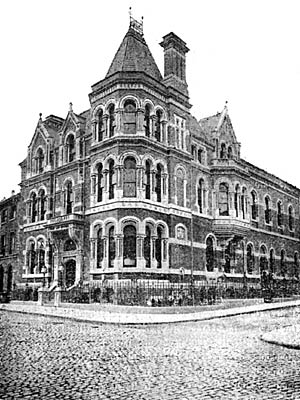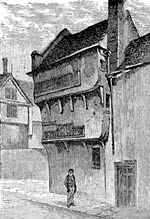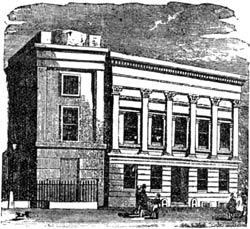
POOR LAW OFFICES.
Before leaving the College, attention must be called to the highly ornate brick and stone building which faces the College entrance. This is the Poor Law Offices, for which purpose it is well planned. The elaborateness of the design may be somewhat out of character with the purposes for which it is used. It is, however, a decided acquisition to the not too numerous handsome public buildings of the town, and reflects credit upon its architect, Mr. Goodall, of Nottingham. The building is handsomely, if not lavishly, furnished. The board room is the prettiest public hall in the town. The building, complete, cost about £16,ooo, and was opened August 18, 1887.
The east wing of the University College is devoted to the purposes of the Central Free Public Library (located in premises in Thurland-street from 1878 to 1881). It is one of the most popular institutions in the borough, being visited by several thousand persons per day. The Central Lending Library and the News Rooms occupy the ground floor, and the Reference (including Patent) Library and Ladies' Reading Room the upper floor. The Library is open from 10 a.m. until 9.30 p.m., and comprises more than 40,000 vols., which are available to residents, free of charge. Would-be borrowers are required to provide security for the return of hooks borrowed by them. There are ten branches of this institution in various parts of the town.
The Free Public Natural History Museum is located in the west wing of the College buildings, and comprises a vertebrate museum on the ground floor, and an invertebrate one on the first floor. The collections of birds, mammalia, fishes, reptiles, butterflies and moths, fossils, corals, sponges, and other interesting natural history objects, are in excellent condition, and are well mounted and arranged. The hours during which the Museum is opened are from 11 am, to 9 p.m., except on Fridays, when it is closed for re-arrangement, cleaning, &c. There is a penny guide to the Museum sold at the doors.
The Libraries and Museum are managed by a Corporation Committee, with outside assistance, and are supported by a rate of a penny in the £ each year. The College, Library, and Museum were formally opened by H.R.H. Prince Leopold, with great eclat, on June 30th, 1881—the foundation stone having been laid September 27th, 1877. Visitors would do well to visit the Libraries, College, and Museum, in the order just indicated.
On the opposite side of the road to the museum, a short distance up the street, is the St. Andrew's English Presbyterian Church, a rough-stone edifice with unfinished spire, situated in Belgrave-square. Just beyond, on the same side of the road—now in Goldsmith-street—is the Masonic Hall, which was opened two days after the College. It was designed, in the "Queen Anne" style, by Mr. Councillor Sutton, is built of brick and terra-cotta, and consists of two large and handsome lodge rooms, several smaller apartments, and a Masonic club room.
Two roads branch off at right angles a little distance beyond. The one to the right—Upper Talbot-street—leads to Victoria Hall, formerly a skating rink, but now used for circus and other purposes; the Marble Rink; Turkish Baths; the handsome lace-dressing rooms of Mr. W. Lambert, J.P., with tower, clock, and hells; and St. Matthew's Church; whilst that to the left—east— leads to the magnificent and recently-erected municipal buildings, the new GUILD HALL, with two facades, in Burton and South Sherwood-streets. This handsome and chaste block of polished stone buildings was erected principally for Police purposes, but it also provides accommodation for the Town Clerk and the Borough Engineer and their staffs. The greatest credit is due to Messrs. Verity and Hunt, not only for the design (which is French Renaissance severely treated, with a Greek feeling), but for the planning of this block of buildings. The main entrance, under a three-bay portico, is in Burton-street. The basement is devoted to the Police; the ground floor to the Magisterial business; and the first floor to Municipal purposes, as already indicated. At the rear are a covered drill yard, the fire engine station, and the firemen's cottages, the latter running parallel with Sherwood-street. The buildings occupy an area of about 7,500 square yards. It is hoped that this magnificent set of public buildings may be inaugurated during the coming summer or autumn by Royalty. The cost of building and furnishing will undoubtedly exceed the sum of £50,000. We give an illustration of this pile by way of frontispiece.
Holy Trinity Schools adjoin these buildings:; and in close proximity is Holy Trinity Church, a neat and substantial stone building in the Early English style, with a graceful spire towering to a height of 172 feet. The nave is 8o feet long, 54 feet wide, and over 30 feet high. It has spacious galleries running round three sides, and was consecrated in £841.
Opposite Trinity Church—in Burton-street and in Milton-street—is a cemented brick building—The Mechanics' Institution, one of the largest and most popular of such institutions. It consists of a large and handsome hall, and smaller hall, let for various purposes; libraries; reading, class, and refreshment rooms. This institution was founded in St. James'-street in 1837. The present building was erected in 1844, partly destroyed by fire March £4,1867, and, after rebuilding, was re-opened Jan. 19, 1869. The entrance to the large hall is in Milton-street. Running parallel with this hall is the new Reading Room of the institution, of good design, though not harmonizing with the main building. The next building to this is the "Mansfield-road Chapel "—although located in Milton-street—of Romanesque style, for a quarter of a century the chapel of the Rev. S. Cox, D.D., the well-known biblical scholar.
Continuing up South Sherwood-street, the offices and works of The Nottingham Guardian will be seen on the left-hand side of the street; and, following the right-hand curve, visitors will find themselves against the Theatre Royal, a massive stone-fronted building, with its six Corinthian columns and heavy entablature—a well-planned, safe, and spiritedly-conducted place of popular amusement, which was opened September 25, 1865. The old theatre was in St. Mary's-gate, near St. Mary's Church. Looking down Parliament-street—to the east—and on the right-hand side, are The Nottingham Express offices, in a domestic style of architecture.
The street facing the Theatre is one of the best thoroughfares in Nottingham—Market-street. This leads to the Market-place, past the entrance to the Palace of Varieties. Visitors may wish to remain for a time to discuss the good things which the restaurants of Long-row, Beastmarket-hill (both parts of the great Market-place), Cheapside, Wheeler-gate, and Albert-street, have provided for their delectation.
Having refreshed "the inner man," and rested, visitors will now be prepared for another ramble through the heart of " the good old town of Nottingham." They should pass the south side of the Exchange, near the massive-looking Bank of Messrs. Smith, and pursue their course up Cheapside and the Poultry. Behind the Exchange, and in an angle on the Cheapside side of the street, is a butcher's shop, adjoining the Shambles. On this is a painting intended to represent Henry Kirke White, the favourite of Nottingham poets.' Near this is a small window, lighting a proportionately small apartment, which has the honour of being designated "Kirke White's Study". Opposite is an old established inn—the Flying Horse.
The street in continuation of The Poultry is Victoria-street. At the commencement of this—at the angle—is the Nottinghamshire Club. The street to the right is one of the oldest thoroughfares in. Nottingham, and is known as Bridlesmith-gate.
[Visitors are now close to St. Peter's-square Tram Terminus—the first street to the right (St. Peter's-gate) leading direct to it]

A BIT OF OLD NOTTINGHAM.
At the right-hand corner of this road stood a "bit of old Nottingham," which was demolished when the street was widened a short time ago. Here is a "cut" of it.
On the same side, higher up, are the handsome offices of the Imperial Insurance Buildings and the commodious Post and Telegraph Offices. The Postal business was transferred from Albert-street, December 15, 1868. Facing the triangular piece of land is Wright's Bank.
The narrow street running parallel with Victoria-street is Pelham-street. On the first street to the right is Thurland-street. Here is located the ornately designed Nottingham and Nottinghamshire Bank, the architect of which was Mr. Fothergill Watson, of this town. Facing is the General Exchange, which was opened in 1850.
The visitor may, if pressed for time, pass down Carlton-street, and enter Stoney-street.

THE GENERAL DISPENSARY.
The next street to the east is George-street, with St. Paul's Church, with a facade consisting of a Doric portico, supported by four columns and a cupola, which is considered a fine specimen of classic architecture. It was designed by Wilkins. The interior is on the plan of the ancient temples. In the same street are the George Hotel, an old-established and well-regulated, and probably the best, hotel in Nottingham; a Catholic School; Particular Baptist and Primitive Methodist Chapels. Adjoining "the George" is a neat and commodious public building—the Nottingham Corporation Gas Office.
